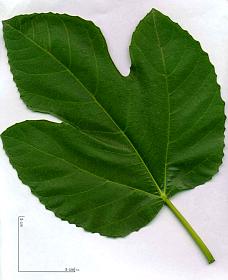Fig tree, Ficus caria
 the family Moraceae includes about 70 genera and one thousand species: there are trees or shrubs mostly tropical, producing latex, leaves alternate, simple, entire or somewhat lobed. the family Moraceae includes about 70 genera and one thousand species: there are trees or shrubs mostly tropical, producing latex, leaves alternate, simple, entire or somewhat lobed.
Etymology: the species name caria comes from the region hence the Greeks thought that the fig was native to.
Origin: Middle East and margins of the Mediterranean.
Lifespan: 300 years.
Habitat : sunny zones (as most Moraceae). It colonizes rocks and walls at the risk of destabilising them with its deep roots. it supports limestones and poor people and contents himself with weak pluviometries. The shadow of the foliage will prevent many vegetables from growing at the foot of the fig tree.
Hardiness: zone 7 (it supports cold until -17 °C or 1 °F).
Height: 12 m tall.
Form (insulated tree): spread.
Smooth bark slightly cracked , pale grey.
Stems : contain the latex, as in other Moraceae.
Deciduous foliage. Big leaves, large (25 cm), thick, tough, 3 - 5 deep lobes, smooth margin, velvety on the underside, harsh on the top.
Fruit: the fig tree grows in tip of stems. Some varieties, as Madeleine, give two harvest a year (variety " bifère "). the fig tree begins producing in the course of its 4th year, reaching its full production at about 12 years.
Botany: species dioecious (male feet and separated female feet). Pollination and fertilization use a wasp (tiny wasp), the blastophaga plenes. It lays eggs in the ovary of the male fig in autumn. Fruits mature in May mammes). They are not edible. The larva develops sheltered from the fruit and flies off in May to pollinate the female flowers. Fruits mature in July (profichis) and are not yet edible. They liberate the larvas which fertilise flowers fichi which, them, give finally figs, without larva, which will be ripe (and edible) in September.
Use: the fig tree is one of the first fruit trees cultivated by men. The Greeks appreciated figs and regulated export. The fig is rich in calcium, potash, phosphorus and iron, and it keeps well once dried out (as dates). The fig is used cool or dried out. Harvested in maturity, it keeps little time. The main European producing countries are Greece, Spain, Portugal and Italy. Among varieties cultivated, most known are Lob Injir de Smyrne, Dottato and San Piero of Italia, and black Aubique in France.
Diseases: the only illness having an economic impact is the Canker of the Fig tree (Diaporthe cinerescens). Viral infections (mosaic transmitted by a dust mite: Aceria fiens), though often visible, seem to be somewhat harmful.
European destructives: Ceroplastes rusci is the most important with the Ringworm of the fig, Eutromula nemorana.
Psylle of the fig tree, Homotoma ficus (L). Hom., attacks leaves.
Planting: by cutting. Sheltered from winds and near a sunny wall. Think of watering (as for any planting) in the first weeks. No pruning needed.
in Paris: nice tree in the small public garden Cain, Le Marais.
Legends and traditions: the sycomore (Ficus Sycomorus) is a fig tree with leaves of mulberry which grows in Egypt and in Syria. It was the "fig of Pharaohs": royal coffins were made. In spite of its name, it is not the maple sycomore of our regions.
In the Bible, Saint Luke names the sycomore:
the greeting of Zachée (Luke 19)
«Jesus entered the city of Jericho, and crossed. However, there was a man named Zacchaeus. He was chief tax collector, and rich. He wanted to see who Jesus was, but he could not do because of the crowd and because he was small.
So he ran ahead and climbed on a sycamore tree to see Jesus who was passing by.
When Jesus was arrived there, he looked up and called out:
- Zacchaeus, hurry down, because it's in your home I'm going to stay today.
Zacchaeus hurried down and received Jesus with joy.»
In Greek mythology, the fig tree is the tree of Dionysos, Priape, God of fecundity. The fig is at the base of regime of the athletes in Olympic period. In Rome, it is dedicated to the god Mars (which has no relation to the peaceful and jovial Dionysos). In the Bible, the fig is a fruit of original sin and its leaf is the first loincloth. For Cleopatra, it was her favorite fruit to the point that the asp which had to kill her had been, at her request, hidden in a basket of figs. In Celtic astrology, character fig is a bit fickle in society... Quintinie, gardener of Louis XIV and fervent defender of the fig, made plantations in the Kitchen garden of the King in Versailles, pruned in fruit-wall, against sunny walls.
Song on the fig tree: À l'ombre bleue du figuier (In the blue shade of the fig tree) of Jean Ferrat.
|